GLASS BOTTLE MARKS ~ HOME PAGE
Hi there ~ I’m interested in the general history of the glass manufacturing industry in the United States, especially that of container glass, electrical insulators and tableware (both pressed and blown). Antique bottles, Fruit jars, Glass insulators, EAPG, Depression Glass, Milk Glass, antique children’s mugs, fishing net floats, and other items are some of the forms of glass I enjoy learning more about. My “GLASS BOTTLE MARKS” website attempts to discuss those subjects and more.
A lot of great information about glass is already available on the web, as well as in numerous books and magazines, but I’ve tried to gather some of the very best, basic info together onto this site, in particular concentrating on glass manufacturers’ identification marks found on bottles, fruit jars, insulators and tableware. I’m also in the process of adding various research articles to this site, with histories or summaries on a number of glass companies, and information about different types of collectible glass and glass items.

The glassmaking industry in the United States is a huge field that dates back to the seventeenth century, and covers a vast array of items and applications, including both handmade and machine-made glass.
According to historian Rhea Mansfield Knittle (Early American Glass, 1927), one of the earliest glass manufacturers in the US (not counting the unsuccessful attempts at Jamestown in 1607 and 1621) who may have produced considerable quantities of glassware and actually met with some degree of success, was Johannes Smedes (or Jan Smedes) who operated an establishment – probably making bottles for the most part – sometime in the period of 1654-1664 at New Amsterdam (now New York City).
What is glass?
Although some collectors and researchers might consider this a question with a fairly “obvious” answer, it’s not quite as simple as that. For a brief, basic discussion on glass (especially concerning the most common type of glass used for containers and tableware), check out my webpage here: What is Glass?
Every glass object, even the most lowly, commonplace glass bottle, has a story behind it, although all of the precise details may never be known. Where was it made? What was the name of the company or factory where it was produced? How old is it? Is it handmade? Was it mass-produced by machine methods? What type of glass is it made of? What elements/chemicals were included in the glass formula or “recipe”? Why is it a certain color? If it’s an older, hand-blown bottle, who was the glassblower who fashioned it? Who was the last person who used it and handled it before it came into your possession? Where was the physical location of the sand supply that eventually was turned into the glass piece that you hold in your hand? Is it American-made, or a piece that was produced outside the United States? Are there letters, numbers, emblems or other graphics embossed into the glass itself? Can the factory or company/glassmaker be identified by the markings on it? What do the markings mean?
Some or all of these questions might come to mind to the collector or layman, student, flea market shopper, historian, researcher, archaeologist, or casual hobbyist. And my site attempts to answer, in at least some cases if possible, these questions: Where, approximately when, and by what company was this piece of glass made?
ADVERTISEMENT
Glass making factories in earlier days were, for the most part, rather unpleasant places … the general inside environment could be, and often was, brutal. It was extremely hot (especially in the warmer months), noisy, dirty, and dangerous for a number of reasons. Injuries, especially burns and cuts, were commonplace. Fire was always a potential occurrence, and many early factories were destroyed by fire, sometimes leading to the complete closing down of a plant and/or failure of a company.
Antique and vintage glassware of all types and styles that are collected, studied and appreciated today are the tangible artifacts and testaments to the remarkable creativity, sheer hard work, energy, endurance, perseverance, and innovation of those men (and women, as well as many young children in the days before the enactment of child labor laws) who worked in those earlier factories.
Five of the webpages on this site list glass manufacturers’ identification marks (alphabetically listed) seen on container glass (bottles, jars, flasks, jugs, etc.) and on other types of glass including handmade and machine-made tableware and cookware.
A few examples of “glass bottle marks” on utilitarian containers would be “I inside a diamond” , “B in a circle“, “R & CO“, and “N inside a square”.
This link points to “PAGE ONE” of the alphabetical mark listings, with introductory information and explanatory comments:
Glass Manufacturers’ Marks on Bottles and Other Glassware, Page One

On this site are a number of individual web pages with basic information on some of the glass factories that operated in the United States. To read any of the glass company profiles I’ve posted (so far) on the Glass Bottle Marks site, and other articles pertaining to glass, please look along the right-hand sidebar of any page (on a computer screen) or at the bottom of the page (on mobile devices) for the menu of “Glass-Related Articles”, and click on any link in that list. I hope to post more articles and add more information as time and energy permits!
One page in particular within this site is a list of glass factories that manufactured, or are believed to have produced, glass electrical insulators for telegraph, telephone and/or power lines. Although mainly listing U.S. factories, a few Canadian factories are listed also. Click here to go directly to that page: ALPHABETICAL LIST OF GLASS INSULATOR FACTORIES / MANUFACTURERS.
If you have additional information, please contact me (at the email address listed on the Contact Information page on this site) as I’m continually looking for the most accurate data available on these companies. Sources of some of the information is included after each entry if I have it available. I’d appreciate any additions, corrections, or suggestions you may have!
NOTE: Searching for words embedded in the text and COMMENTS sections of each page on this site
Many readers have landed on this site after a keyword search on one of the online search engines such as Google or Bing. The search results page may have included a brief snippet of text from this site. A quick keyword search of the text and especially the COMMENTS section (at the bottom of this and other pages on the site) might be helpful.
On some pages, there are hundreds of comments. (On this Welcome page alone, there are over 700 comments archived here). On a computer screen, press the CTRL key, and (while holding it down) the F key (Find) on your keyboard. Then type in a word or letters you are looking for in the search box. This should scan all the text on this page including the comments – this may help to find a search term you were interested in – a specific glass factory name, business or company name, city or state name, or other words, phrases or initials contained within the text.
If you are using a mobile device, look for the “three stacked dots” or “three horizontal lines” (Menu) along the top or bottom of the screen, tap and look for “FIND IN PAGE” in the dropdown menu. Select that option and a keyboard should appear. Type in the word or phrase to see if it appears within the text or the comments section on that webpage. I hope this helps!
ADVERTISEMENT

Some of the information on glass insulators is from research originally compiled by N. R. Woodward, creator of the “CD” (Consolidated Design) numbering system now used worldwide by collectors for identifying and cataloging insulators. A portion of the info in this site pertaining to insulator manufacturers is drawn from various articles in the classic 2-volume reference book “INSULATORS: A HISTORY AND GUIDE TO NORTH AMERICAN GLASS PINTYPE INSULATORS“ by John & Carol McDougald (published in 1990).
The glass insulator pictured here, a blue aqua or “Hemingray Blue” CD 257 “Mickey Mouse”, is a type made for power lines, made by the Hemingray Glass Company at their factory that operated in Muncie, Indiana.
This site is a “work in progress” started in February of 2004. Originally, the core material was posted as a “sub-page” on the umbrella site Myinsulators.com (hosted by webmaster Bill Meier), but in September of 2012 I moved to my own “Glass Bottle Marks” domain name, and have since expanded this site with additional articles. I would also like to thank the many people around the country (and some from outside the US) with whom I’ve communicated by email, and who, over the years, have sent me photos of glass marks, some of them posted in the alphabetical listings.
I hope this website will be of help in your quest to discover more information concerning the wide world of glass and glass manufacturing. Please be sure to bookmark my site, and return often!
Thank you!
~David
COMPLETE LIST OF ALL ARTICLES ON THIS SITE
SURNAME-ORIENTED ANTIQUE BOTTLE COLLECTING
GLASS MANUFACTURERS MARKS -ALPHABETICAL PAGES – PAGE ONE
ADVERTISEMENT


